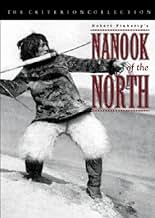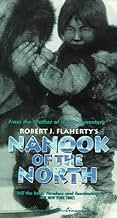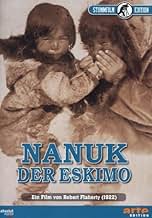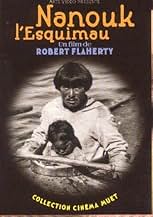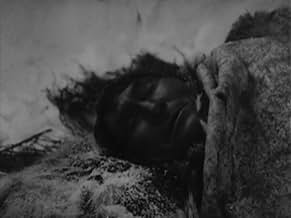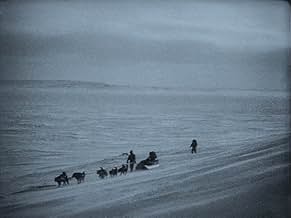IMDb रेटिंग
7.6/10
14 हज़ार
आपकी रेटिंग
अपनी भाषा में प्लॉट जोड़ेंIn this silent predecessor to the modern documentary, film-maker Robert J. Flaherty spends one year following the lives of Nanook and his family, Inuits living in the Arctic Circle.In this silent predecessor to the modern documentary, film-maker Robert J. Flaherty spends one year following the lives of Nanook and his family, Inuits living in the Arctic Circle.In this silent predecessor to the modern documentary, film-maker Robert J. Flaherty spends one year following the lives of Nanook and his family, Inuits living in the Arctic Circle.
- निर्देशक
- लेखक
- स्टार
- पुरस्कार
- कुल 2 जीत
फ़ीचर्ड समीक्षाएं
Robert Flaherty is one of the more noted documentarians in the history of film. It is not without some concentration (ironically maybe) to watch his most well-known work, Nanook of North, which is as much documentary as it is almost the very first widely seen "Home movie". There's no narration aside from the several title cards listing the obvious things that Nanook and his family/tribe are doing in the arctic.
Therefore this is much more of a visual kind of documentary, not as outrageous and experimental as those of Dziga Vertov of the same period (using what camera equipment available, shooting seemingly on the fly), but with a distinct view on what life is usually like for these people. We basically see them doing very elementary tasks, more based on living day-to-day in this harsh climate than anything overly dramatized.
That all of the scenes are really 'staged' (and, apparently, it's not even Nanook's real wife) doesn't deter the viewer from what is being shown. It's like a mix of the objective and subjective- objective in the sense that 'this is what it is, the Eskimos hunting for food, raising their children, making their shelter in igloos, and making trips to ensure their survival'. Subjective in that Flaherty's camera is creating a specific view of these people, their faces captured memorably in the scratchy print of the film. In a way it's also like the first, and perhaps more groundbreaking, of the lot of nature documentaries to follow over the years, though to a primitive extreme.
In all, Nanook of the North is meant to above all show the versatility of these people, both the physical nature (i.e. hunting the seal, which is the most exciting in the film) and the nature of the spirit of these people, living this way as a cycle over and over again.
Therefore this is much more of a visual kind of documentary, not as outrageous and experimental as those of Dziga Vertov of the same period (using what camera equipment available, shooting seemingly on the fly), but with a distinct view on what life is usually like for these people. We basically see them doing very elementary tasks, more based on living day-to-day in this harsh climate than anything overly dramatized.
That all of the scenes are really 'staged' (and, apparently, it's not even Nanook's real wife) doesn't deter the viewer from what is being shown. It's like a mix of the objective and subjective- objective in the sense that 'this is what it is, the Eskimos hunting for food, raising their children, making their shelter in igloos, and making trips to ensure their survival'. Subjective in that Flaherty's camera is creating a specific view of these people, their faces captured memorably in the scratchy print of the film. In a way it's also like the first, and perhaps more groundbreaking, of the lot of nature documentaries to follow over the years, though to a primitive extreme.
In all, Nanook of the North is meant to above all show the versatility of these people, both the physical nature (i.e. hunting the seal, which is the most exciting in the film) and the nature of the spirit of these people, living this way as a cycle over and over again.
"Nanook of the North" is a film that shows the life of Nanook and his family back in 1920 in the frozen North of Canada. Most of the film shows Nanook hunting and fishing--most other activities are not seen.
I'll be honest about this one--"Nanook of the North" is NOT a film for everyone. It's a semi-documentary with very limited appeal. I am not surprised that it was released as part of the ultra-artsy Criterion Collection. After all, how many people want to see a film about the life of the Inuit in Northern Canada?! However, for fans of documentaries, it's well worth seeing, as it's one of the very early ones. But you might have noticed that I called it a 'semi-documentary'--a term that should be used more often. That's because a true documentary shows what is--not a fictional account of what is. And, while what you see is typical in some ways about the Inuit, it was NOT typical of the Inuit in 1920. These folks no longer hunted and lived like they did in this film due to their contact with the outside world. And so, what you see is more like the Inuit BEFORE they made contact with the modern world. Apparently, in 1920, these folks were using guns and other modern bits of technology that are not shown in the film. Additionally, the filmmaker staged much of the film. For example, Nannok's wife in the film really isn't his wife! But with all these problems, is the film worthless? Certainly not!! It's fascinating from start to finish and is more like a recreation of ancient Inuit life--and in this sense, it's an invaluable record--but one most people probably don't care much about today--mostly it's a film for academicians and film historians.
I'll be honest about this one--"Nanook of the North" is NOT a film for everyone. It's a semi-documentary with very limited appeal. I am not surprised that it was released as part of the ultra-artsy Criterion Collection. After all, how many people want to see a film about the life of the Inuit in Northern Canada?! However, for fans of documentaries, it's well worth seeing, as it's one of the very early ones. But you might have noticed that I called it a 'semi-documentary'--a term that should be used more often. That's because a true documentary shows what is--not a fictional account of what is. And, while what you see is typical in some ways about the Inuit, it was NOT typical of the Inuit in 1920. These folks no longer hunted and lived like they did in this film due to their contact with the outside world. And so, what you see is more like the Inuit BEFORE they made contact with the modern world. Apparently, in 1920, these folks were using guns and other modern bits of technology that are not shown in the film. Additionally, the filmmaker staged much of the film. For example, Nannok's wife in the film really isn't his wife! But with all these problems, is the film worthless? Certainly not!! It's fascinating from start to finish and is more like a recreation of ancient Inuit life--and in this sense, it's an invaluable record--but one most people probably don't care much about today--mostly it's a film for academicians and film historians.
Years ago, in high school, I had to sit through a creaky, dim and dirty, silent black and white documentary about some Eskimo. I remember nothing of the film except that I didn't like it. Today, I had the opportunity to see a recently restored and nicely scored re-release of that film: Nanook of the North. After all the National Geographic, Nova, PBS and Discovery Channel documentaries I have seen over the years chronicling the lives of aboriginal bands of people, (aboriginal people often wearing Coca-Cola T-shirts and baseball caps), this classic 1922 epic is the best I've ever seen showing a happy people working desperately to survive in an incomprehensibly harsh environment. It is quite a compliment to the film and its subject that it retains so much power almost 80 years after it was created. The film simply documents a small group of Inuit and their children in northeast Canada as they struggle to live from day to day. That these people survive at all, let alone remain a seemingly happy, life-loving team in such a place is mind-boggling. So many of the brutally realistic scenes in this wonderful film remind me of how sterilized many contemporary documentaries have become. We see the necessary brutality of finding, stalking and killing your food. Then slicing up your kill right there on the ice and eating it where it died. We witness Nanook harpooning and then `reeling in' a walrus, catching fish with no hook and no real bait and somehow knowing where to dig a tiny hole in the ice. Then, through that tiny hole, he spears and battles to bring in a seal. And he succeeds. But more than the environment and more than the struggle, what keeps us watching this film is character. Nanook is the chief of the small tribe and the father in the main family that is followed. He is smart, curious, inventive, determined and, at the core, a happy, gregarious character that we learn to laugh with, root for and celebrate with as he keeps his family fed. His children are an absolute delight, playful and endearing, seemingly oblivious to the awful world in which they live. The film seems to have no artifice at all and everything seems to be a regular part of their life with little attention paid to the camera. If you are a lover of the documentary form, you cannot miss this re-release. It appears to have been struck from a near pristine negative and restored to its original length of somewhere over 65 minutes. The pleasant score is not too obtrusive and sounds as though it may be a reconstruction of the score composed for the theatrical re-release of the film in 1939, but the credits aren't completely clear on that. See this film.
Nanook of the North was a delight to watch from start to finish. What is captured on film is a priceless glimpse into an Eskimo family's life from the early days of film-making. Some people consider the film to be pejorative; particularly in the portrayal of Nanook as simple-minded enough to think little people live inside a phonograph speaker; or in the next frame where he is portrayed confusing a phonograph record with something to eat. I was not offended by this; conversely, considering when the film was made these scenes were endearing to me. Ultimately, what I like best about this film are the close-ups of Nanook and his family, particularly his children. The emotions expressed on their faces when they are happy and playful or sad and afraid reveal the universal link we all share as humans. It is a link that transcends the vast spaces of both cultural distance and time. The film is a masterpiece!
As a documentary turning point, Nanook of the North is undoubtedly one of if not the most significant work of the twentieth century. The story of Nanook and his family became the center of attention of the national media and virtually altered the perceptions the world had of film for documentary purposes. Flaherty may be to the documentary world what J.R.R. Tolkien is to the fantasy world. He is the giant of the genre. For its time, Nanook of the North was a masterpiece. Simple and profound, the story of Nanook was unique, and henceforth the foundation upon which the great documentarians of the 20th century created their works. However, through hindsight, the film falters. Most noticeable is the fact that Flaherty composed each of these sequences ahead of time and purposefully altered Nanook's life in order to make it seem harsher. In what is one of the most famous scenes, Nanook laughs at a phonograph and bites into a record as if he does not understand it. However, it was discovered later that not only had Nanook seen phonographs before, but he was a regular visitor to the trading post, owned a snowmobile and a rifle, and had probably seen a record player before. This fact puts into question the strength of this work as a documentary. Flaherty defended himself, claiming that some things need to be altered in order for the message to be seen. However, this is what we in the film world call "fiction". Plenty of fiction is based upon fact, but when you call something a documentary, it is held up to a different standard, one that Flaherty's work, although, good, fails to achieve.
क्या आपको पता है
- ट्रिवियाThe claim that Allakariallak died of starvation in 1922, months after the film was completed, is untrue; he did not starve but likely succumbed to tuberculosis.
- भाव
Title Card: The shrill piping of the wind, the rasp and hiss of driving snow, the mournful wolf howls of Nanook's master dog typify the melancholy spirit of the North.
- क्रेज़ी क्रेडिटA story of life and love in the actual arctic.
- इसके अलावा अन्य वर्जनRemastered with image enhancement, speed correction and a new score in 1998
- कनेक्शनEdited into Saumialuk. Le grand gaucher (1990)
टॉप पसंद
रेटिंग देने के लिए साइन-इन करें और वैयक्तिकृत सुझावों के लिए वॉचलिस्ट करें
- How long is Nanook of the North?Alexa द्वारा संचालित
विवरण
बॉक्स ऑफ़िस
- बजट
- $53,000(अनुमानित)
- चलने की अवधि
- 1 घं 18 मि(78 min)
- ध्वनि मिश्रण
- पक्ष अनुपात
- 1.33 : 1
इस पेज में योगदान दें
किसी बदलाव का सुझाव दें या अनुपलब्ध कॉन्टेंट जोड़ें


